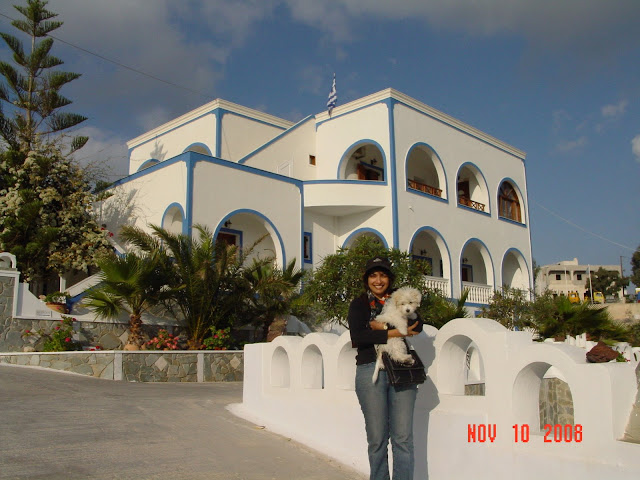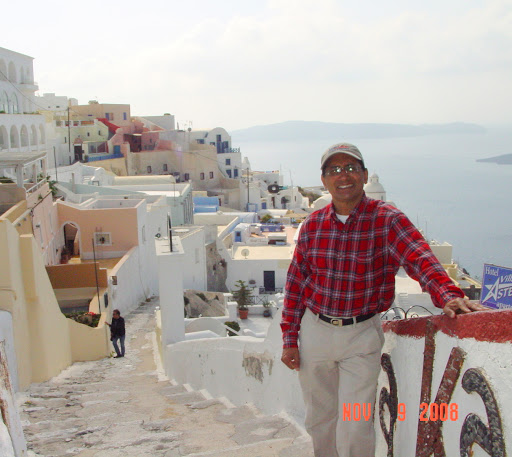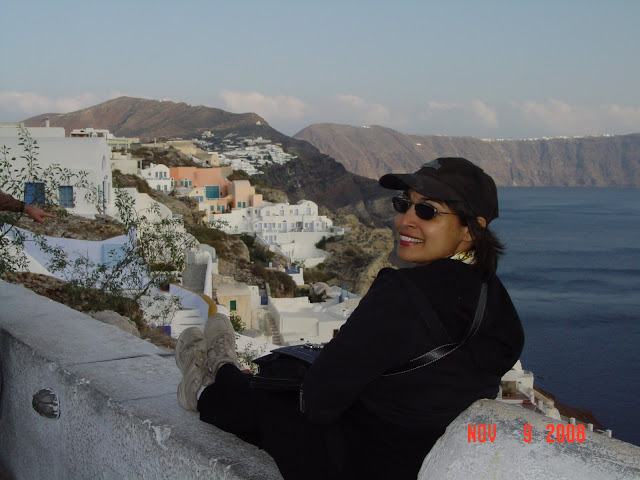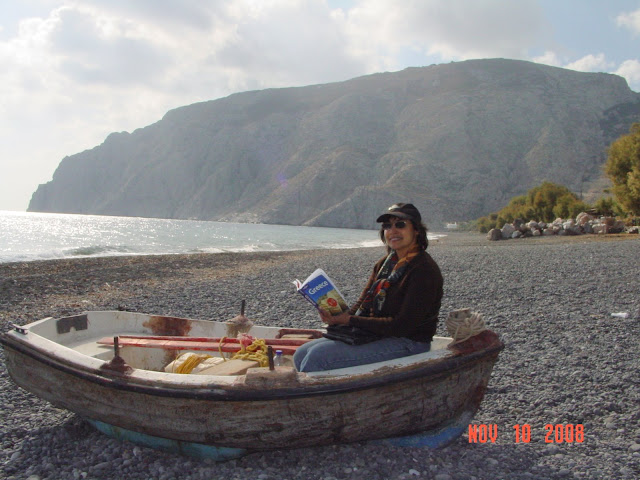At Fira on the Island of Santorini with the volcanic slopes behind us.
Santorini is reputed to be the most beautiful of the Greek Islands, so it is not surprising that almost all cruise ships plying the Mediterranean make a mandatory stop here. This has also bestowed a peculiarly snazzy aura to the island that belies the simplicity and authenticity of its native people. Of course, when spared the madding tourist crowd, the island offers pure delights of natural scenery and spectacular sunsets and it was in search of those that Llew and I included it in our itinerary.
We had snatched a few zzzs on the Romilda as it made its way around the Cyclades by night stopping at Argos and Tinos and Ios and a number of smaller islands before depositing us before daylight at Athonios Port where Agapi, our landlady from Villa Agapi, awaited us with a placard proclaiming the name of her establishment. Despite the fact that dawn had not yet broken over the island, I could discern the steep rocky cliffs that loomed above us giving Santorini its distinctive profile.
 As we wound our way by car over the mountain roads with Agapi at the wheel, we took in the strangeness of these new environs–large expanses of virgin land lay waiting to be discovered. Frenetic construction activity all over the island proclaimed the new economic boom that has led to its recent prosperity. When we did arrive at the white and turquoise blue highlighted building that is Villa Agapi, we were enchanted by the kidney shaped pool and its matching blue and white striped deckchairs and umbrellas. The repetitive colors of blue and white made me wonder if the Greeks pay tribute to their blue and white striped flag that is ubiquitous or whether these colors reflect the azure-blue Aegean waters and the white washed houses and churches that dominate its landscape.
As we wound our way by car over the mountain roads with Agapi at the wheel, we took in the strangeness of these new environs–large expanses of virgin land lay waiting to be discovered. Frenetic construction activity all over the island proclaimed the new economic boom that has led to its recent prosperity. When we did arrive at the white and turquoise blue highlighted building that is Villa Agapi, we were enchanted by the kidney shaped pool and its matching blue and white striped deckchairs and umbrellas. The repetitive colors of blue and white made me wonder if the Greeks pay tribute to their blue and white striped flag that is ubiquitous or whether these colors reflect the azure-blue Aegean waters and the white washed houses and churches that dominate its landscape.
Half past six was no time to contemplate these possibilities and so we settled for a snooze in our lovely comfortable rooms whose balconies provided unbridled views of the sea. At 9 am, we made our way to the Reception area for a hearty Continental breakfast of toast and Lurpak butter (I have developed a huge liking for Lurpak) and strawberry jam, strong coffee and a chocolate marbled cake with orange juice.
 Well fortified against the rigors of the sightseeing that lay ahead, we took bus directions from Agapi to get to Fira, the nearest and largest town on the island. But despite waiting for a quarter of an hour, we were not rewarded with the sight of a bus and my weak feet prompted me to do something I haven’t done in years–stick out my thumb and hitch a ride. How delighted we were when a car stopped within a few minutes and a lovely young lady named Angela, en route to her job as a salesgirl in an expensive jewelry store, told us to hop in.
Well fortified against the rigors of the sightseeing that lay ahead, we took bus directions from Agapi to get to Fira, the nearest and largest town on the island. But despite waiting for a quarter of an hour, we were not rewarded with the sight of a bus and my weak feet prompted me to do something I haven’t done in years–stick out my thumb and hitch a ride. How delighted we were when a car stopped within a few minutes and a lovely young lady named Angela, en route to her job as a salesgirl in an expensive jewelry store, told us to hop in.
Footloose in Fira:
Angela also proved to be a worthy tour guide and, at her suggestion, we began our exploration of the town at the pale peach and blue Dominican Monastery perched at the very top end of the town. This extremely evocative space presented to us the uniqueness of Byzantine Church design–a central dome covered with mosaics or paintings and one or a pair of steeples that flank it. The atmosphere in these environs was quaint and spoke of ancient worlds and it was quite enchanting to explore these quarters.
 What I found most interesting about Santorini and what makes it different from Mykonnos was the streets–while those in Mykonnos are composed of large flag stones cemented together with white mortar, the ones in Santorini feature tiny black volcanic cobbles held together by cement paste. The effect is very pretty indeed and since the entire town is covered with this flooring, it brings a kind of uniformity to the space.
What I found most interesting about Santorini and what makes it different from Mykonnos was the streets–while those in Mykonnos are composed of large flag stones cemented together with white mortar, the ones in Santorini feature tiny black volcanic cobbles held together by cement paste. The effect is very pretty indeed and since the entire town is covered with this flooring, it brings a kind of uniformity to the space.
Fira’s town center is composed basically of three main streets that sit in tiers, one on top of the other, on the volcanic mountainsides. These mountains rise tall along the water’s edge, the result of volcanic activity, centuries ago, that have left huge craters on the island’s surface and have created hot springs on the neighboring isles that lie just across the port. We passed by a number of shops and cafes, bars and tavernas–some sold high-end merchandise such as crystal by Baccarat and Lalique and gold jewelry. Clearly targeted at the cruise crowd, these stores were so different from the little souvenir stalls that exuded local color.
Following signs that led towards the cable car, we ran into Angela again at her store. It was she who pointed out the mule paths to us–the one that allows visitors to climb the mountainside on the backs of these sturdy animals if they prefer not to take the cable car, the island’s newest nod to technology. This vantage point offered stunning vistas as far as the eye could see and we posed for many pictures before we decided to explore the smaller shops. Along the coastal path were a variety of restaurants such as Franco’s of Fira which offer startling views and must be hugely popular in the summer. Most of them were closed for the season but we had no regrets at all as we enjoying wandering through the narrow streets without having to elbow our way through frenzied tourist hordes. At the southern tip of the town, we arrived at the pure white Byzantine Cathedral, unfortunately closed, but, nevertheless, creating a distinctive addition to the landscape with its dome and tiered walls.
It was then time to go out in search of lunch and having read up a lot on the native ingredients of Santorini, we decided to find a place that would serve us the local delicacies. These include the “waterless” tomatoes, a variety that is never watered but receives its water only from the precipitation in the atmosphere. There are also fava beans that are made into a mash and served with red onions. Saganaki is a cheese that is batter clad and deep fried in the style of Italian mozarella sticks. Fortunately, a restaurant called Ceasar’s that served both Italian and typical Greek food was open and we seated ourselves at a table and ordered the traditional Greek medzes platter–an idea that allows for casual ‘grazing’ and a taste of several preparations at the same time. So we were thrilled when we were presented a variety of nibbles–those famous tomatoes, the fava bean mash, tzakiki (cucumber-yoghurt dip flavored with garlic), taramasalata (fish roe dip–far more yummy than it sounds!), olives, feta cheese, aubergine mash, cucumbers and capers, served with lovely toasted garlic bread. We also asked for the Saganaki cheese and enjoyed the whole thing with the local Greek beer called Mythos which was extremely refreshing when served cold. Everywhere we went we loved the food. Not for nothing does the Mediterranean Diet have such a fine international reputation. We found ourselves eating healthy and very reasonably priced meals and resolved to include some aspects of this cuisine into our daily eating habits.
Sunset at Ia:
 Replete with our lunch, we were able to go out in search of the local bus station to take a ride to Ia, the village that sits perched high up on the volcanic cliffs and promises some of the most stunning sunsets in the Cyclades. Several other tourists had the same idea and we were soon off on a ride that offered turquoise views of the Aegean at every turn–literally–for the bus snaked around the mountain roads, twisting and turning precariously as it confronted hairpin bends.
Replete with our lunch, we were able to go out in search of the local bus station to take a ride to Ia, the village that sits perched high up on the volcanic cliffs and promises some of the most stunning sunsets in the Cyclades. Several other tourists had the same idea and we were soon off on a ride that offered turquoise views of the Aegean at every turn–literally–for the bus snaked around the mountain roads, twisting and turning precariously as it confronted hairpin bends.
 Soon, we were at Ia, walking along its charming cobbled streets and passing by its houses and shops, most slumbering softly in the bright sunshine as it was siesta-time! Few signs of life presented themselves to us and but for the innumerable stray cats and dogs that populate every one of the Greek islands, there was no life in sight. We did, however, run into two middle-aged American women from Birmingham, Alabama, who expressed the opinion that were most unhappy with America’s new President Elect and told us that they were en route to “Is-tin-bul”. We also met another American couple from Louisiana, on their honeymoon in Greece, who unable to find a ferry to Crete which they intended to explore, were stranded on Santorini for a week–well, I can think of worse places to spend a honeymoon! They were relentless explorers and the lady complained to me of aching calves from all the walking they had done in the past few days. I told her to make sure she supports her arches with really good walking shoes!
Soon, we were at Ia, walking along its charming cobbled streets and passing by its houses and shops, most slumbering softly in the bright sunshine as it was siesta-time! Few signs of life presented themselves to us and but for the innumerable stray cats and dogs that populate every one of the Greek islands, there was no life in sight. We did, however, run into two middle-aged American women from Birmingham, Alabama, who expressed the opinion that were most unhappy with America’s new President Elect and told us that they were en route to “Is-tin-bul”. We also met another American couple from Louisiana, on their honeymoon in Greece, who unable to find a ferry to Crete which they intended to explore, were stranded on Santorini for a week–well, I can think of worse places to spend a honeymoon! They were relentless explorers and the lady complained to me of aching calves from all the walking they had done in the past few days. I told her to make sure she supports her arches with really good walking shoes!
 Ia is not much different from Fira. The structures hug the sides of the cliff and seem to hang precariously over the steep precipice at every curve. However, they have charming and very unique architectural details that give the Grecian islands their own ambience. A vast number of churches are sprinkled over the cliffs, their domes painted in vivid turquoise. Gates and doorways are painted in bold primary colors while the walls of these structures are washed in pale ice-cream shades of pink and peach. Most houses are arched and there is rarely a straight line on a structure. This gives the entire town the sense of flowing along the mountains on tiered waves. Onward we pressed towards the northern-most tip of the island in the hope of finding the spot from which the grand sunsets are spied.
Ia is not much different from Fira. The structures hug the sides of the cliff and seem to hang precariously over the steep precipice at every curve. However, they have charming and very unique architectural details that give the Grecian islands their own ambience. A vast number of churches are sprinkled over the cliffs, their domes painted in vivid turquoise. Gates and doorways are painted in bold primary colors while the walls of these structures are washed in pale ice-cream shades of pink and peach. Most houses are arched and there is rarely a straight line on a structure. This gives the entire town the sense of flowing along the mountains on tiered waves. Onward we pressed towards the northern-most tip of the island in the hope of finding the spot from which the grand sunsets are spied.
When we did get there, we found it to be a castle-like stone structure mounted on the promontory for the particular pleasure of watching the sun sink over the Aegean horizon. A few of the tourists who had boarded our bus had beaten us to it and they were taking pictures against every angle and curve of the island. Llew and I settled down to watch the drama of the scenery spread out before us–the glimmering sea beneath us, the unique island landscape of Greece around us–and discovered that on the opposite side of Ia, the colors are different–or are completely absent. Indeed, the other side of Ia is a plain dazzling white, created by painting sides, domes and walls of structures in a uniform white. But this is far from bland–in fact, it is startling because when streaks of color do occasionally appear–in the base of windmills, for instance, or against the dome of a church–it is so enlivening and so charming.
Darkness comes early to Greece in the autumn and we expected the sun to set at about 5. 30 pm. However, the last bus returning to Fira was scheduled to leave at 5 pm. Deciding that it was not worth missing the bus, since low monsoon clouds had amassed themselves at the horizon and would have obscured our views of the sinking sun, we decided to get a move on and walk towards the bus stop. As the bus wound its way downhill, we could see the golden lining on the grey clouds at the horizon and felt comforted for we had not made an unwise decision to leave.
Back in Fira, we found a souvlaki stall and decided to buy ourselves take-out kebas. We had missed the last bus to Karterados where our Villa Agapi was located, so took a cab for five euros to our doorstep. We ate our takeaway dinner in our hotel after which Llew watched Greek TV to obtain some snatches of Obama’s victory while I spent time reading up on Greece’s history.
Santorini was indeed sensational and undoubtedly deserves its reputation. We were glad that we would have the next morning to continue to enjoy this corner of the earth that seemed somehow so far removed from Time.
A Blissfully Lazy Day in Kamari:
 We had almost a half day to explore Santorini on our own before we boarded our ferry back to Pireaus Port. I would have loved to have visited “Ancient Thira” (as Santorini was once known), but the archeological site had closed for the season. I had no regrets, however, as we had already examined the lovely frescoes from Akroteri, the site that dates from 3,000 BC and has preserved wonderful Cretan frescoes on its walls. These have been excavated and are now preserved in the National Archaeological Museum in Athens where we had seen them.
We had almost a half day to explore Santorini on our own before we boarded our ferry back to Pireaus Port. I would have loved to have visited “Ancient Thira” (as Santorini was once known), but the archeological site had closed for the season. I had no regrets, however, as we had already examined the lovely frescoes from Akroteri, the site that dates from 3,000 BC and has preserved wonderful Cretan frescoes on its walls. These have been excavated and are now preserved in the National Archaeological Museum in Athens where we had seen them.
Instead, we decided to take a bus to Kamari Beach and enjoy a quiet, uneventful day on the sands. Or so we wished! As it turned out, we had a nice little adventure en route. In attempting to hop into a bus, we had spent more than a half hour waiting and finally opted to hitchhike again. Only no one seemed to be going in the direction of Kamari. In frustration, we stood on the opposite side of the road intending to hitchhike back to Fira. We were luckier this time round, for a nice man stopped and took us in and just a few meters on the road to Fira, we saw the Fira-Kamari bus go sailing by. The driver was so amused, he laughed heartily at our dismay. Then, suddenly hit by a brainwave, he asked us if we still wanted to get to Kamari. If we can, we said. Well, let’s try to follow that bus, he said, and catch up with it at a town ahead. So, before we could say “Aristotle Onassis”, he U-turned his car around and began following the public bus! As expected, the bus soon arrived at the little town of Messaria, where a number of passengers waited in a queue to board it. This gave us a few seconds to thank him profusely, dash out of his car and hop into the bus. We laughed at our little adventure and settled down into our seats to arrive at Kamari Beach about ten minutes later.
Kamari Village seemed abandoned of all humanity when we arrived there. Not a human being was in sight though the local ‘supermarket’ was open. Equipping ourselves with freshly-baked spanakopita and chocolate croissants and chestnut yogurt, we walked along the silent streets towards the beach that beckoned insistently at the end of the road.
“Let’s sit somewhere in the sun”, Llew said, “and enjoy our meal”.
“I’m heading towards the sun”, I responded. “Let’s eat our breakfast on the beach”.
And that indeed was exactly what we did. Llew was stunned by his first sight of Kamari Beach which lay devoid of any human traffic. The sand was black—one of the famous volcanic black sand beaces of Greece similar to the one we had seen on Hawaii’s Big Island. I spied a small deserted boat on the water’s edge and suggested to Llew that we should climb into it and enjoy our breakfast right in there, while gazing over the ocean. And that was exactly what we did! On our right, the volcanic cliffs loomed forbiddingly, their folds like giant elephant’s legs. On our right, the land curved around charmingly and behind us lay the promenade with its low buildings. The color of the waters of the Aegean seemed particularly striking that morning as the sun gleamed upon its crystal-clear surface and gilded the waves. We stuck our fingers into the waves to test the temperature and found it to be deceptively welcoming. Truly, we could have stayed there all day, but after a couple of hours, when Llew had been a beach comber, literally combing the beach of its assorted litter and bagging it for the garbage bins, we decided to go and explore the village.
There were still few signs of life. Some fancy boutiques were open but nothing enticed us. We sat for a long while awaiting the arrival of the bus that eventually took us back to our villa at Karterados where we napped for a couple of hours, in keeping with the Mediterranean custom of taking leisurely siestas.
Then, it was time for us to board our ferry, The Blue Star Itaki and cruise on the ink-dark Aegean for the last time. At promptly 3. 30 pm, our ferry left Santorini offering us our last glimpses of its salmon-pink houses perched on charcoal-dark cliffs. Out on the deck, we took pictures of the swiftly slipping sights, then settled down inside to enjoy the long sail to Pireaus Port in Athens, where we arrived close to midnight.
Without any further delay, we boarded the last metro for the night that took us to Monastiraki, where we walked, with newly-gained assurance, to the souvlaki place called Thannasis, then carried our dinner back to Acropolis House which seemed like an old friend and made us feel as if we had arrived home.
To read about our last day in Greece, please click on the link to Athens.
Bon Voyage!
